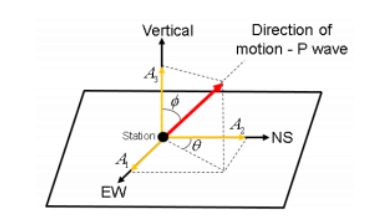Article
On the Selection of Wavelet Models in the Simulation of Seismic Accelerograms through Evolutionary Optimization

Downloads
 Download
Download

This work is licensed under a Creative Commons Attribution 4.0 International License.
Copyright
The authors shall retain the copyright of their work but allow the Publisher to publish, copy, distribute, and convey the work.
License
Prevention and Treatment of Natural Disasters (PTND) publishes accepted manuscripts under Creative Commons Attribution 4.0 International (CC BY 4.0). Authors who submit their papers for publication by Prevention and Treatment of Natural Disasters (PTND) agree to have the CC BY 4.0 license applied to their work, and that anyone is allowed to reuse the article or part of it free of charge for any purpose, including commercial use. As long as the author and original source is properly cited, anyone may copy, redistribute, reuse and transform the content.
Keywords:
Seismic waves Waveforms Error of fit Three components of ground acceleration Backtracking search optimization algorithmReferences
- Housner, G.W., 1947. Characteristics of strong-motion earthquakes. Bulletin of the Seismological Society of America. 37(1), 19-31. DOI:https://doi.org/10.1785/BSSA0370010019
- Bycroft, G.N., 1960. White noise representation of earthquakes. Journal of the Engineering Mechanics Division (ASCE). 86, 1-16. DOI: https://doi.org/10.1061/JMCEA3.0000125
- Tajimi, H., 1960. A statistical method of determining the maximum response of a building structure during an earthquake. In: Proceedings of 2th World Conference in Earthquake Engineering, Tokyo, Japan. 1, 781-797.
- Kanai, K., 1961. An empirical formula for the spectrum of strong earthquake motions. Bulletin Earthquake Research Institute. (39), 85-95.
- Clough, R., Penzien, J., 1993. Dynamics of Structures. McGraw-Hill, Inc.
- Shinozuka, M., Sato, Y., 1967. Simulation of nonstationary random process. Journal of Engineering Mechanics (ASCE). 93, 11-40. DOI: https://doi.org/10.1061/JMCEA3.0000822
- Iyengar, R.N., Iyengar, K.T.S., 1969. A nonstationary random process model for earthquake acceleration. Bulletin of the Seismological Society of America. 59(3), 1163-1188. DOI: https://doi.org/10.1785/BSSA0590031163
- Amin, M., Ang, A.H.S., 1968. Non-stationary stochastic model of earthquake motion. Journal of Engineering Mechanics (ASCE). 94, 559-583. DOI: https://doi.org/10.1061/JMCEA3.0000969
- Bruna, R.A., Riera, J.D., 1988. Towards the simultaneous generation of the three components of the seismic acceleration on rock surface. Nuclear Engineering & Design. 110(2), 153-163. DOI: https://doi.org/10.1016/0029-5493(88)90017-9
- Dalla Chiesa, D., Miguel, L.F.F., 2019. Methodology for simulation of the three components of seismic acceleration. Bulletin of the Seismological Society of America. 109(6), 2427-2436. DOI: https://doi.org/10.1785/0120190042
- Dalla Chiesa, D., Miguel, L.F.F., Riera, J.D., 2021. Simultaneous simulation of the three components of seismic accelerograms at locations around seismological stations. Journal of Seismology. 25, 1361-1384. DOI: https://doi.org/10.1007/s10950-021-10050-z
- Iturrioz, I., Riera, J.D., 2021. Assessment of the Lattice Discrete Element Method in the simulation of wave propagation in inhomogeneous linearly elastic geologic materials. Soil Dynamics and Earthquake Engineering. 151, 106952. DOI: https://doi.org/10.1016/j.soildyn.2021.106952
- Spanos, P.D., Giaralis, A., Politis, N.P., 2007. Numerical Treatment of Seismic accelerograms and of Inelastic Seismic Structural Responses Using Harmonic Wavelets. Computer-Aided Civil and Infrastructure Engineering. 22, 254-264. DOI: https://doi.org/10.1111/j.1467-8667.2007.00483.x
- Newland, D.E., 1994a. Wavelet analysis of vibration, Part I: Theory. Journal of Vibrations and Acoustics. 116(4), 409-416. DOI: https://doi.org/10.1115/1.2930443
- Newland, D.E., 1994b. Wavelet analysis of vibration, Part II: Wavelet maps. Journal of Vibrations and Acoustics. 116(4), 417-425. DOI: https://doi.org/10.1115/1.2930444
- Newland, D.E., 1999. Ridge and phase identification in the frequency analysis of transient signals by harmonic wavelets. Journal of Vibrations and Acoustics. 121(2), 149-155. DOI: https://doi.org/10.1115/1.2893957
- Gurley, K., Kareem, A., 1999. Applications of wavelet transforms in earthquake, wind and ocean engineering. Engineering Structures. 21, 149-167. DOI: https://doi.org/10.1016/S0141-0296(97)00139-9
- Montejo, L.A., Suárez, L.E., 2006. Wavelet-based identification of site frequencies from earthquake records. Journal of Earthquake Engineering. 10(4), 565-594. DOI: https://doi.org/10.1080/13632460609350610
- Amiri, G.G., Shahjouei, A., Saadat, S., et al., 2011. Hybrid Evolutionary-Neural Network Approach in Generation of Artificial Accelerograms Using Principal Component Analysis and Wavelet-Packet Transform. Journal of Earthquake Engineering. 15(1), 50-76. DOI: https://doi.org/10.1080/13632469.2010.517281
- Yamamoto, Y., Baker, J.W., 2013. Stochastic Model for Earthquake Ground Motion Using Wavelet Packets. Bulletin of the Seismological Society of America. 103(6), 3044-3056. DOI: https://doi.org/10.1785/0120120312
- Domingues, M.O., Mendes, O., Kaibara, M.K., et al., 2016. Explorando a transformada wavelet contínua. Revista Brasileira de Ensino de Física. 38. DOI: https://doi.org/10.1590/1806-9126-RBEF2016-0019
- Civicioglu, P., 2013. Backtracking search optimization algorithm for numerical optimization problems. Applied Mathematics and Computation. 219(15), 8121-8144. DOI: https://doi.org/10.1016/j.amc.2013.02.017
- Miguel, L.F.F., Miguel, L.F.F., Lopez, R.H., 2016a. Simultaneous optimization of force and placement of friction dampers under seismic loading. Engineering Optimization. 48(4), 582-602. DOI: https://doi.org/10.1080/0305215X.2015.1025774
- Miguel, L.F.F., Miguel, L.F.F., Lopez, R.H., 2016b. Failure probability minimization of buildings through passive friction dampers. Structural Design of Tall and Spectral Buildings. 25(17), 869-885. DOI: https://doi.org/10.1002/tal.1287
- Kennett, B.L.N., Engdahl, E.R., 1991. Travel times for global earthquake location and phase association.Geophysical Journal International. 105, 429-465. http://ds.iris.edu/spud/earthmodel/10131355.
- Bollettino Sismico Italiano - Istituto Nazionale di Geofisica e Vulcanologia, Centro Nazionale Terremoti. http://bollettinosismico.rm.ingv.it/.
- Castello, B., Selvaggi, G., Chiarabba, C., et al., 2006. CSI Catalogo della sismicità italiana 1981-2002, versione 1.1. INGV-CNT, Roma. http://www.ingv.it/ CSI/.
- ESM - Engineering Strong-Motion database. (accessed April 2021). https://esm.mi.ingv.it
- Luzi, L., Lanzano, G., Felicetta, C., et al., 2020. Engineering Strong Motion Database (ESM) (Version 2.0). Istituto Nazionale di Geofisica e Vulcanologia (INGV).DOI: https://doi.org/10.13127/ESM.2
- Trifunac, M.D., Brady, A.G., 1975. A Study of the duration of strong earthquake ground motion. Bulletin of the Seismological Society of America. 65(3), 581-626. DOI: https://doi.org/10.1785/BSSA0650030581


